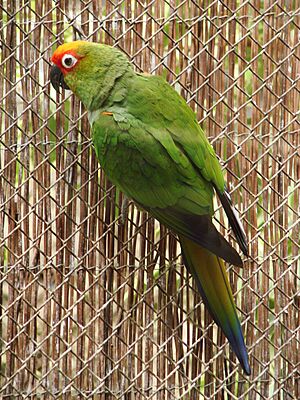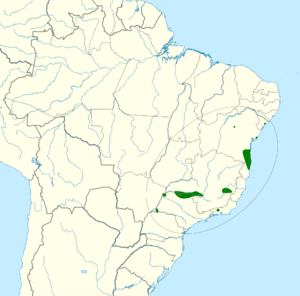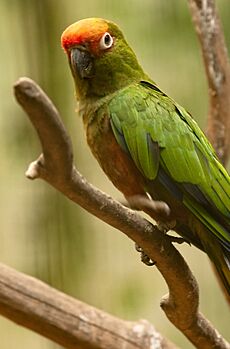Golden-capped parakeet facts for kids
Quick facts for kids Golden-capped parakeet |
|
|---|---|
 |
|
| Conservation status | |
| Scientific classification | |
| Genus: |
Aratinga
|
| Species: |
auricapillus
|
 |
|
| Synonyms | |
|
Aratinga auricapilla (Kuhl, 1820) |
|
The golden-capped parakeet (Aratinga auricapillus) is a colorful parrot found in Brazil and Paraguay. These birds live in different types of forests, dry grasslands called savannas, and even on farms. Sadly, their homes are shrinking because of habitat loss. The golden-capped parakeet is important because it helps scientists understand how healthy a forest is. This is because they are sensitive to changes in their environment.
Contents
What Golden-Capped Parakeets Look Like
Golden-capped parakeets are about 30 cm (12 in) long. They are mostly green. They have a black beak and white rings around their eyes. Their belly is orange-red, and their face is red. This red color fades to yellow on top of their head.
Young parakeets don't have these bright colors yet. They get their yellow head markings and red belly as they grow into adults. These parakeets usually weigh around 4.9 to 5.25 ounces.
About Their Name
The golden-capped parakeet is also known as the golden-capped conure. The name Aratinga was created for medium to small parrots from South America.
Scientists sometimes group animals into smaller groups called subspecies. The golden-capped parakeet has a subspecies called A. a. aurifrons. The main difference between them is slight color variations. For example, A. a. aurifrons might have less red on its back and less yellow on its head. Scientists are still studying if this difference is enough to call them separate subspecies.
Golden-Capped Parakeet Behavior
Golden-capped parakeets usually live in groups. These groups can have anywhere from 4 to 15 birds. They tend to stay together in the forests where they live.
Reproduction and Life Cycle
The breeding season for these parakeets happens during the summer in the southern hemisphere. This is from December to March. You might see pairs of birds together around November. Young birds that can fly are usually seen around March.
Female parakeets lay about 3 to 5 eggs in a nest. The eggs hatch after about 25 days. The young birds, called fledglings, take about 7 to 8 weeks to learn how to fly.
Where Golden-Capped Parakeets Live
The Aratinga auricapillus mostly lives in the semi-deciduous forests of northeastern Brazil. These are forests where some trees lose their leaves in the dry season. Over time, these parakeets have learned to live in other places too. You can find them in farming areas and sometimes even in cities. They are spread across many states in Brazil, including Bahia, Minas Gerais, Espírito Santo, Rio de Janeiro, São Paolo, Goiás, and Paraná.
What Golden-Capped Parakeets Eat
Golden-capped parakeets mainly eat fruit. This means they are frugivorous. However, they also eat other things. Their diet can include seeds, flower petals, buds, nectar, and even lichens.
A study from 2010 to 2012 looked at what these parakeets eat. Researchers noticed that the birds often ignored the outer parts of fruits. They mostly ate the seeds inside. Some of the plants they were seen eating from include West Indian Elms, maize (corn), silk floss trees, common guavas, pterogynes, and chinaberry trees.
Because people are building more farms and cities near their homes, the parakeets have also started eating cultivated fruits and seeds. This includes things like citrus fruits, papaya, mango, and corn.
Status of the Golden-Capped Parakeet
The number of golden-capped parakeets has been going down. This is mainly because of deforestation, which means forests are being cut down. However, these parakeets are often found outside the main forests. They also live in many areas across Brazil and Paraguay.
A survey in 2018 in Minas Gerais, Brazil, found that golden-capped parakeets were "Frequent" in the region. Other surveys in national parks also showed that their small population is managing to stay stable. Efforts to protect parrots and their homes have helped slow their decline.
However, there are still concerns. Poachers sometimes capture these exotic birds to sell as pets. Also, their habitat is being lost to farms for livestock, coffee, sugarcane, and soybeans. Because of these reasons, the golden-capped parakeet is listed as "Least Concern" on the IUCN's Red List. This means they are not in immediate danger, but their situation is still watched closely.



